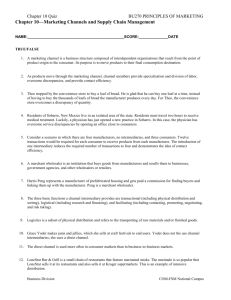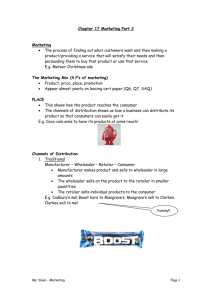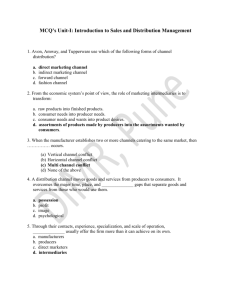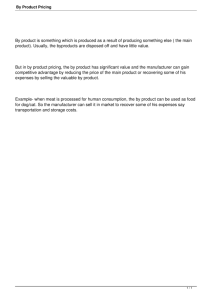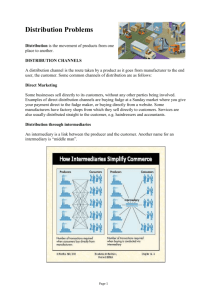Student Handout - Mr. George Academics
advertisement
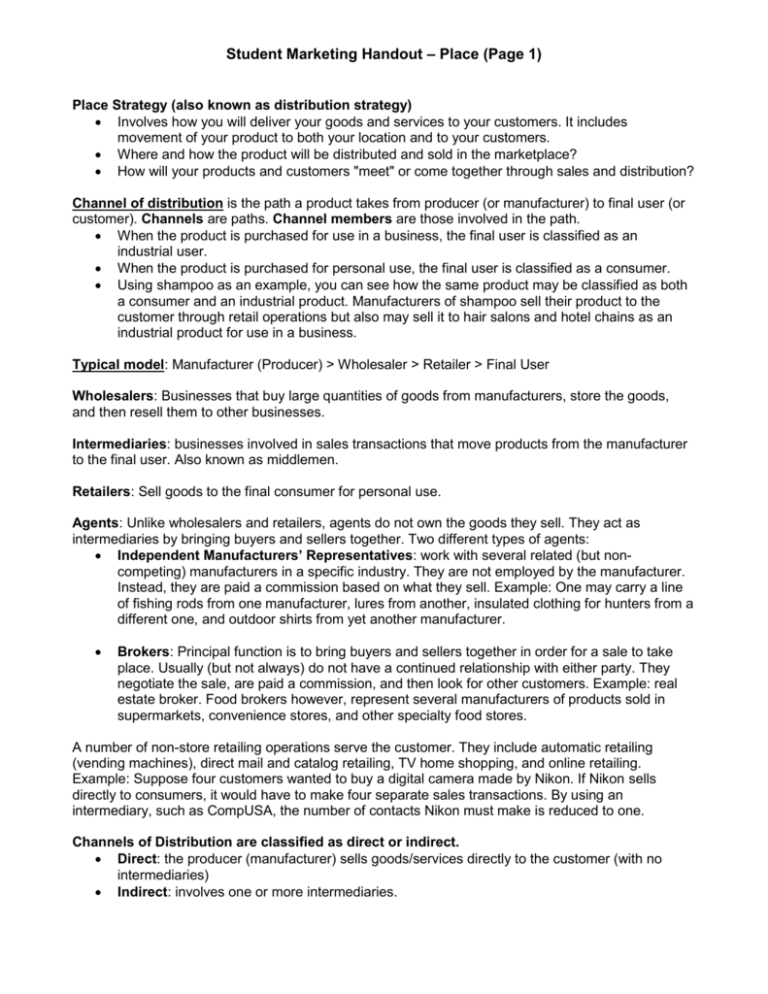
Student Marketing Handout – Place (Page 1) Place Strategy (also known as distribution strategy) Involves how you will deliver your goods and services to your customers. It includes movement of your product to both your location and to your customers. Where and how the product will be distributed and sold in the marketplace? How will your products and customers "meet" or come together through sales and distribution? Channel of distribution is the path a product takes from producer (or manufacturer) to final user (or customer). Channels are paths. Channel members are those involved in the path. When the product is purchased for use in a business, the final user is classified as an industrial user. When the product is purchased for personal use, the final user is classified as a consumer. Using shampoo as an example, you can see how the same product may be classified as both a consumer and an industrial product. Manufacturers of shampoo sell their product to the customer through retail operations but also may sell it to hair salons and hotel chains as an industrial product for use in a business. Typical model: Manufacturer (Producer) > Wholesaler > Retailer > Final User Wholesalers: Businesses that buy large quantities of goods from manufacturers, store the goods, and then resell them to other businesses. Intermediaries: businesses involved in sales transactions that move products from the manufacturer to the final user. Also known as middlemen. Retailers: Sell goods to the final consumer for personal use. Agents: Unlike wholesalers and retailers, agents do not own the goods they sell. They act as intermediaries by bringing buyers and sellers together. Two different types of agents: Independent Manufacturers’ Representatives: work with several related (but noncompeting) manufacturers in a specific industry. They are not employed by the manufacturer. Instead, they are paid a commission based on what they sell. Example: One may carry a line of fishing rods from one manufacturer, lures from another, insulated clothing for hunters from a different one, and outdoor shirts from yet another manufacturer. Brokers: Principal function is to bring buyers and sellers together in order for a sale to take place. Usually (but not always) do not have a continued relationship with either party. They negotiate the sale, are paid a commission, and then look for other customers. Example: real estate broker. Food brokers however, represent several manufacturers of products sold in supermarkets, convenience stores, and other specialty food stores. A number of non-store retailing operations serve the customer. They include automatic retailing (vending machines), direct mail and catalog retailing, TV home shopping, and online retailing. Example: Suppose four customers wanted to buy a digital camera made by Nikon. If Nikon sells directly to consumers, it would have to make four separate sales transactions. By using an intermediary, such as CompUSA, the number of contacts Nikon must make is reduced to one. Channels of Distribution are classified as direct or indirect. Direct: the producer (manufacturer) sells goods/services directly to the customer (with no intermediaries) Indirect: involves one or more intermediaries. Student Marketing Handout – Place (Page 2) Both consumer markets and industrial markets use direct and indirect channels of distribution. Different channels of distribution can be used to reach the customer. Despite the potential for success that any product may seem to have, it can fail if the wrong channels are used. Examples for Consumer Market Direct: Factory outlet stores, farmers’ roadside stands, using catalogs to generate sales, Internet online sales Indirect: Retail clothing stores, buy a John Deere tractor from Home Depot, buy Marvin windows from Abington lumber, automobiles, most supermarket items Summary: Fewer consumer products are marketed using direct distribution (as consumers are use to shopping in retail stores) Examples for Industrial Market Direct: sales representatives call directly to commercial businesses- Xerox sells a copier machine to Dependable Cleaners; Caterpillar sells a forklift to Hingham lumber Indirect: wholesaler takes ownership and buys restaurant supplies (pots, pans, utensils) from manufacturer and sells to restaurant owners. Summary: Industrial users shop differently and have different needs from consumers, so they use different channels of distribution. The least used channel in the consumer market – direct distribution- is the most used channel in the industrial market. Distribution Planning Major considerations include the use of multiple channels, control versus costs, intensity of distribution, and involvement in e-commerce. Multiple channels: Producer must identify the best channel for each market (i.e. J&J Snack Foods sells its pretzels, drinks and cookies to supermarkets, movie theaters, sports arenas, schools, colleges, and hospitals). Control vs. Costs Have its own direct sales force or hire agents to do the selling? Distribution intensity o Exclusive distribution: protected territories of a product in a given geographic area. Dealers are given exclusive rights to protected areas. o Integrated distribution: Manufacturer acts as wholesaler and retailer for its own products. Example: Gap sells its clothing in company-owned retail stores. o Selective distribution: Limited number of outlets in a given geographic area is used to sell the product. Goal is to select channel members that can maintain the image of the product, are good credit risks, aggressive marketers and good inventory planners. Example: Armani sells its clothing only through top department stores that appeal to the affluent customers who buy its merchandise. It doesn’t sell its goods in a chain mega store with a very different target market. o Intensive distribution: Involves the use of all suitable outlets to sell a product. Objective is complete market coverage, and ultimate goal is to sell to as many customers as possible, wherever they choose to shop. Example: motor oil is sold in automotive repair shops, auto parts retailers, supermarkets, hardware stores, warehouse clubs, and other retail stores to reach maximum number of customers. E-commerce: products are sold to customers and industrial buyers through the Internet. Physical Distribution (logistics): Comprises all the activities that help to ensure that the right amount of product is delivered to the right place at the right time. It involves order processing, transporting, storing, stock handling, and inventory control of materials and products. Student Marketing Handout – Place (Page 3) Conclusion: To succeed in today’s business environment, a company must deliver its products to customers around the country and throughout the world in the most efficient and effective way. Location, layout and availability are important to your place strategy. They are especially important to retail and service businesses that rely on customers to come to them. Is the exchange of the product made in a store? Through the mail? Through a direct sales representative? What are your production and inventory capacities? (How quickly can you make products and how many can you store?) Where will your product be placed so customers have access to it? Are there cyclical fluctuations or seasonal demands for your products? For example, if you produce Christmas decorations, how will you manage peak production and sales periods as well as slow periods? In closing: In terms of place strategy, there are many decisions that need to be made. Making the correct place decisions will have a major impact on the successful operation of a business.


